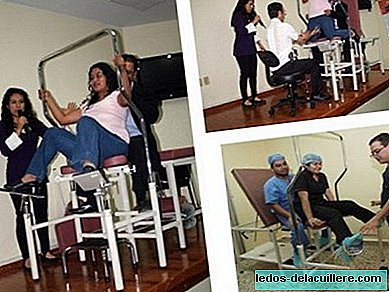
Vertical birth today is seen as something strange, but not a few decades ago and in many cultures from centuries to today. Vertical births are being introduced in Mexican hospitals when equipping the delivery rooms with vertical “stretchers”.
According to leaders of the Oaxaca Health Services, 86% of women give birth in less than 30 minutes (expulsion phase) with the vertical delivery technique, reducing pain with better results for the mother and the baby. To a greater extent, medication, caesarean sections and complications, the use of forceps and episotomy are avoided.
The last to get a obstetric table for vertical delivery it has been the general hospital "Doctor Aurelio Valdivieso".
Those responsible for this new kit remember that when the baby is born vertically, as it is still practiced in indigenous areas, the process is faster, because by force of gravity the baby is better accommodated to pass through the pelvis. In addition, the birth canal manages to open two centimeters more than when the woman is lying down, which favors the baby's exit.
In Mexico, Oaxaca was a pioneer in performing vertical births and today he is a model to follow in the states of San Luis Potosí, Colima, Morelos and Tabasco, and stressed that there are currently two thousand traditional midwives registered in the Mixteca, Costa, Istmo and Tuxtepec regions.
From the module of humanized birth and vertical and gyneco-obstetric delivery of the "Aurelio Valdivieso" hospital, it is noted that since the program was launched (April 2009), 300 deliveries have been attended vertically.
WHO also notes that vertical birth seems to be associated with several benefits, including the reduction in the duration of the period of labor delivery. While waiting for confirmation about these benefits, you should allow women to choose the position they want to have the birth.
The obstetric table for humanized delivery in a vertical position is somewhat bizarre for me, it consists of two foot supports, a frame to make it easier for the woman to push, an individual support for the back that at the same time folds down becoming a seat for your partner and Provide physical and emotional support.
The difference of this method with respect to squatting or with support without table is that the obstetrician is at the same height of the patient, although it is an advantage for him, of course. To me it still seems like a table that is too “orthopedic”, artificial, complex and that may end up constraining the mother, who sometimes looks more like a tightrope walker That a parturient.
The fact is that if this new possibility is given to women with vertical delivery that arrives at Mexican hospitals, new options are being offered, always welcome. The next step: let the woman move and decide her position in the hospital, which WHO recommends.











)
